|
Tachymeter & Telemeter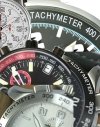
Chronograph watches allow you to measure time using the stopwatch function (start-stop button usually at the 2 o'clock position).
It tells you the traveling speed over a fixed distance in km/hour or miles/hour. You can also use it to measure a production process in units/hour. While the scale markings may look complicated at first glance to the uninitiated, reading the tachymeter is really easy. Here's how. (Oh, before you start using the tachymeter, your watch should be in the chronograph (stopwatch) mode where the second hand is resting still at the 12 o'clock position. Many of you already knew that but this is just a gentle reminder, just in case.)
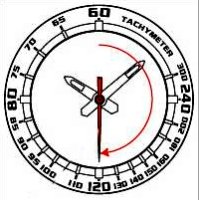 For example, we want to know the speed of a moving car. For example, we want to know the speed of a moving car.Start the chronograph when the car passes a predetermined starting line or marker A, and stop the chronograph when the car passes the next line or marker B, 1 km (or mile) away. The second hand is pointing at 6 o'clock. Read the tachymeter value at that position and it shows 120, telling us that the car was traveling at a speed of 120 km/h (or miles/h).
For example, we want to know how fast a 200m athlete is running. Start the stopwatch when the race starts, and stop it when the athlete crosses the finishing line. Let's say the athlete crossed the line at 20 seconds. The tachymeter value at the 20 second mark (4 o'clock position) shows 180, which means 180 km/h if the distance timed was 1 km. But the athlete only ran one-fifth of a kilometer. Therefore, we need to divide 180 by 5 (1/5 of 180) to get 36 km/h, which is the speed of the athlete in that 200 m race.
Let's say an aircraft took 35 seconds to cover a distance of 10 km. The tachymeter shows us a speed of 100 km/hour at the 35 seconds mark. However, 10 km have been traveled. Therefore the speed of the aircraft is 100 x 10, which is 1000 km/h.
This means the process has a production output rate of 200 units per hour. How to read the Telemeter 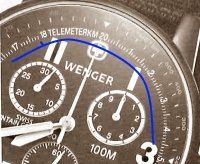 Some watches are equipped with the telemeter scale, which tells you the approximate distance between the user and an event that can be both seen and heard. The scale is usually defined in kilometers or miles depending on the watch model. Examples of events that are seen and then heard are lightning and thunder, fireworks and artillery firing.
In the example shown, the distance is 8.7 km.
Although it is not a constant value since it is affected by factors such as altitude and temperature, the speed of sound can be specifically calculated using mathematical formulas. As such, telemeter scales on chronograph watches are generally calibrated based on the speed of sound at sea level, which is calculated to be approximately 340 m/s.
Based on the speed of sound, you can simply calculate the distance using the good old equation, Distance = Speed x Time So, knowing the speed of sound to be 340 m/s and the time elapsed between the event seen and heard is 30 seconds, the approximate distance is therefore 10,200 m, which is 10 km as shown on the telemeter scale above.
Return from Tachymeter to World Military Watches Command
|
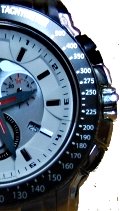 Many chronograph models are equipped with the tachymeter scale on the watch bezel or surrounds the dial.
Many chronograph models are equipped with the tachymeter scale on the watch bezel or surrounds the dial. 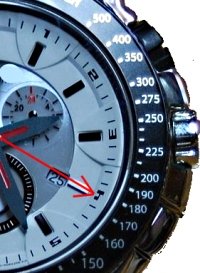 No problem, but a little simple calculation is required.
No problem, but a little simple calculation is required.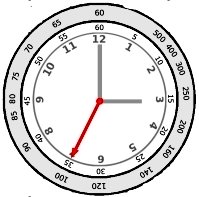
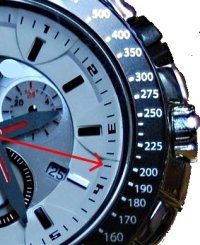 Measuring Production Process in units per hour
Measuring Production Process in units per hour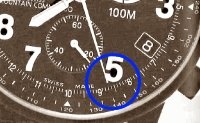
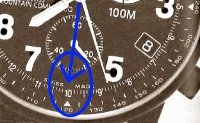 At the 30 seconds mark, the telemeter tells us the distance to the artillery firing (heard 30 seconds after sighting the firing) is approximately 10 km.
At the 30 seconds mark, the telemeter tells us the distance to the artillery firing (heard 30 seconds after sighting the firing) is approximately 10 km.